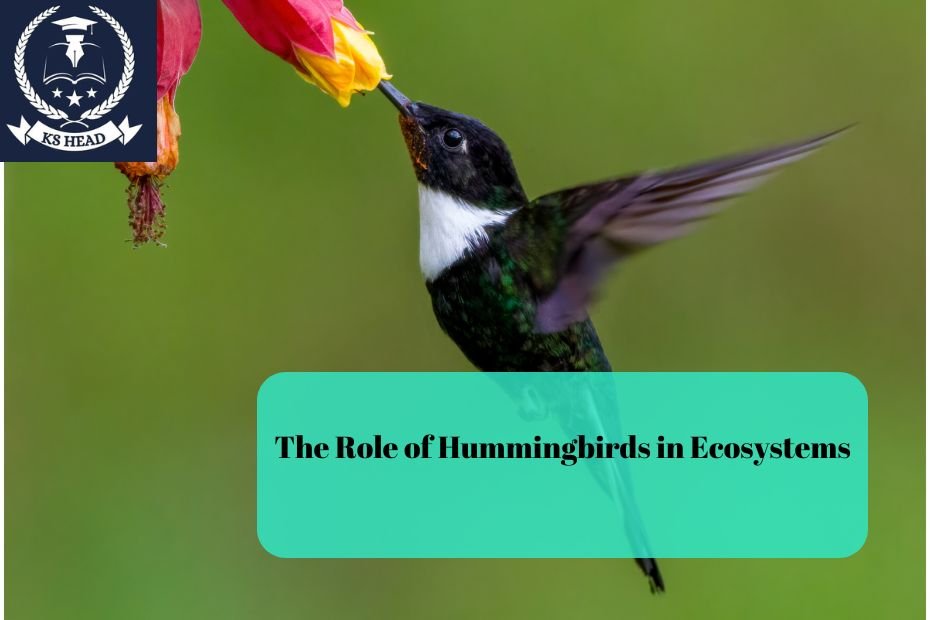Hummingbirds, known for their vibrant plumage and astonishing flying abilities, play a significant role in maintaining the balance and health of various ecosystems. These tiny yet powerful creatures, primarily found in the Americas, are crucial pollinators, seed dispersers, and indicators of environmental health. Despite their small size, hummingbirds have evolved to fill important ecological niches, contributing to biodiversity and the overall functioning of ecosystems.
In this article, we will explore the ecological role of hummingbirds, their relationships with plants, their impact on biodiversity, and their importance in maintaining the health of natural habitats. Understanding the role of these birds offers insights into the intricate connections that make ecosystems thrive.
1. Pollination: Hummingbirds as Essential Pollinators
One of the most significant roles that hummingbirds play in ecosystems is their contribution to pollination. Pollination is a crucial process for the reproduction of flowering plants, enabling them to produce seeds and propagate. While bees and butterflies are often recognized as primary pollinators, hummingbirds also play a key role, particularly in regions where insects are less effective or abundant.
How Hummingbirds Pollinate
Hummingbirds are attracted to brightly colored flowers, particularly those in red, orange, or pink hues. These flowers often have tubular shapes, which are perfectly suited for the bird’s long, slender beak and specialized tongue. As hummingbirds feed on the nectar of these flowers, their heads brush against the flower’s reproductive organs, transferring pollen from one flower to another. This act of pollination allows the plant to reproduce and ensures genetic diversity.
Unique Adaptations for Pollination
Hummingbirds are specially adapted to feed on nectar. Their wings beat rapidly, allowing them to hover in place while feeding. This enables them to access flowers that other pollinators cannot reach. Their long, forked tongues are equipped with grooves that facilitate nectar extraction. These adaptations make them highly efficient pollinators, particularly for flowers that have co-evolved to rely on hummingbirds.
Importance in Different Ecosystems
In tropical and subtropical regions, where hummingbird diversity is greatest, these birds are critical to the survival of numerous plant species. In fact, many plants in these regions are specially adapted to be pollinated exclusively by hummingbirds. Without hummingbirds, the reproduction of these plants would be severely hindered, affecting the entire ecosystem.
2. Seed Dispersal: Maintaining Plant Diversity
In addition to pollination, hummingbirds also contribute to seed dispersal, which is another vital ecological function. While many birds and mammals play a role in spreading seeds, hummingbirds are particularly important in certain environments, especially in tropical forests where they feed on fruits and berries.
Role in Seed Dispersal
Although nectar is the primary food source for most hummingbirds, some species consume small fruits and insects. When they consume fruit, they inadvertently swallow seeds, which are later excreted at different locations. This helps plants colonize new areas, increasing plant diversity and supporting ecosystem resilience.
Impact on Plant Communities
Hummingbirds help maintain plant diversity by dispersing seeds over a wide range of areas. This natural process helps prevent the dominance of a single species, allowing various plant species to coexist. A diverse plant community supports a wide range of wildlife, including insects, mammals, and other bird species. By contributing to seed dispersal, hummingbirds help ensure the stability and health of ecosystems.
3. Hummingbirds as Bioindicators of Ecosystem Health
Hummingbirds serve as important bioindicators, meaning that their presence and behavior can reflect the health of an ecosystem. Because hummingbirds are sensitive to changes in their environment, scientists can monitor their populations to assess the impact of habitat loss, climate change, and pollution.
Sensitivity to Environmental Changes
Hummingbirds require specific resources to survive, including nectar-rich flowers, insects, and nesting sites. Any disturbance to these resources—whether from deforestation, urbanization, or climate fluctuations—can affect hummingbird populations. A decline in hummingbird numbers can indicate problems within the ecosystem, such as habitat degradation or loss of biodiversity.
Climate Change and Hummingbird Migration
Climate change is affecting the migratory patterns of many bird species, including hummingbirds. As temperatures rise and flowering times shift, hummingbirds may arrive at their breeding or feeding grounds when nectar sources are not available. This mismatch between food availability and hummingbird presence can lead to population declines, which further impacts the plants and animals that rely on them.
Conservation Efforts
Conservation programs aimed at preserving hummingbird populations often focus on protecting their habitats, especially in regions where deforestation and habitat fragmentation are widespread. The preservation of hummingbird habitats also protects a multitude of other species, emphasizing the interconnectedness of ecosystems.
4. Relationships with Plants: Co-Evolution
Hummingbirds and certain plant species have evolved together over millions of years, forming mutually beneficial relationships. This co-evolution is evident in the specialized traits of both the birds and the plants they pollinate.
Floral Specialization
Many plant species have developed traits that attract hummingbirds, such as bright colors and tubular flower shapes. In return, hummingbirds have evolved beaks and feeding behaviors that allow them to access nectar efficiently. This co-evolution has led to a deep interdependence between hummingbirds and these plants.
Impact on Plant Reproduction
Hummingbirds increase the reproductive success of these specialized plants by ensuring cross-pollination. Because hummingbirds are highly mobile, they can transfer pollen over large distances, promoting genetic diversity and helping plants adapt to changing environmental conditions.
5. Ecological Importance of Hummingbird Species Diversity
There are over 300 species of hummingbirds, each occupying different ecological niches. This diversity ensures that hummingbirds can pollinate a wide variety of plants, contributing to the health of multiple ecosystems.
Niche Specialization
Different hummingbird species have evolved to feed on different types of flowers, allowing them to coexist in the same habitats without competing for resources. For example, some species prefer higher elevations, while others thrive in lowland tropical forests. This niche specialization ensures that various plant species receive the pollination they need to survive.
Supporting Biodiversity
Hummingbird species diversity supports the overall biodiversity of ecosystems. By pollinating different plants, hummingbirds help maintain diverse plant communities, which in turn support a wide array of animals. A biodiverse ecosystem is more resilient to environmental changes and can better withstand the impacts of climate change, habitat destruction, and other threats.
6. Hummingbirds’ Role in Food Webs
Hummingbirds are an integral part of the food web in many ecosystems. While they are primarily nectar feeders, they also consume small insects and spiders, contributing to pest control. In turn, hummingbirds are preyed upon by larger birds, reptiles, and mammals, forming part of the larger predator-prey dynamics in their habitats.
Controlling Insect Populations
Although nectar is their main source of energy, hummingbirds also feed on insects to meet their protein needs. By consuming small insects and spiders, they help control insect populations, which can benefit both plants and humans by reducing the number of pests in the environment.
Prey for Larger Animals
Hummingbirds themselves are prey for various predators, including hawks, snakes, and larger birds. This predation keeps hummingbird populations in balance and maintains the overall health of the ecosystem. The role of hummingbirds in food webs illustrates how interconnected all species are within an ecosystem.
Conclusion
Hummingbirds are more than just beautiful creatures that captivate our attention with their vibrant colors and incredible flying abilities. They are essential players in the health and functioning of ecosystems, acting as pollinators, seed dispersers, and bioindicators. Their interactions with plants, their sensitivity to environmental changes, and their role in food webs demonstrate the vital connections that sustain biodiversity.
The protection and conservation of hummingbird habitats are crucial, not only for the survival of these birds but for the health of ecosystems as a whole. By preserving hummingbirds, we help maintain the delicate balance that supports countless other species, ensuring that ecosystems remain resilient in the face of environmental challenges.
FAQs
1. How do hummingbirds help in pollination?
Hummingbirds pollinate flowers by transferring pollen from one flower to another as they feed on nectar, helping plants reproduce and promoting biodiversity.
2. Why are hummingbirds considered bioindicators?
Hummingbirds are sensitive to environmental changes, and their population levels can indicate the health of an ecosystem. Declines in their numbers may signal habitat degradation or other ecological problems.
3. What do hummingbirds eat besides nectar?
In addition to nectar, hummingbirds consume small insects and spiders to meet their protein needs, contributing to pest control in their habitats.
4. How does climate change affect hummingbirds?
Climate change affects hummingbird migration and the timing of flower blooming, potentially leading to mismatches between food availability and the birds’ arrival at breeding or feeding grounds.
5. What can we do to help hummingbird populations?
Protecting natural habitats, planting native flowers, and reducing pesticide use are some ways to support hummingbird populations and help maintain the health of ecosystems.

